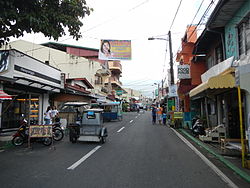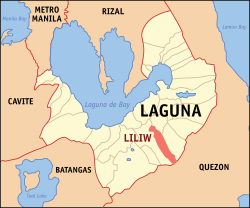Liliw
Liliw | |
|---|---|
| Municipality of Liliw | |
 Downtown area | |
| Nickname: Flip-flops Capital of the Philippines[1] | |
| Motto(s): "Baleng Ganda, Baleng Saya" | |
 Map of Laguna with Liliw highlighted | |
 | |
Location within the Philippines | |
| Coordinates: 14°07′48″N 121°26′10″E / 14.13°N 121.436°E | |
| Country | |
| Region | Calabarzon |
| Province | Laguna |
| District | 3rd district of Laguna |
| Founded | August 29, 1571 |
| Barangays | 33 (see Barangays) |
| Government | |
| • Type | Sangguniang Bayan |
| • Mayor | Ericson J. Sulibit |
| • Vice Mayor | Arnold A. Montesines |
| • Congressman | Marisol A. Sampelo |
| • Electorate | 25,875 voters (2022) |
| Area | |
| • Total | 39.10 km2 (15.10 sq mi) |
| Elevation | 256 m (840 ft) |
| Population (2020 census)[4] | |
| • Total | 39,491 |
| • Density | 1,000/km2 (2,600/sq mi) |
| • Households | 10,706 |
| Economy | |
| • Income class | 4th municipal income class |
| • Poverty incidence | 3.92% (2015)[5] |
| • Revenue (₱) | ₱ 137.5 million (2020) |
| • Assets (₱) | ₱ 286.8 million (2020) |
| • Liabilities (₱) | ₱ 132.1 million (2020) |
| • Expenditure (₱) | ₱ 114.1 million (2020) |
| Time zone | UTC+8 (PST) |
| ZIP code | 4004 |
| PSGC | |
| IDD : area code | +63 (0)49 |
| Native languages | Tagalog |
| Website | www |
Liliw, officially the Municipality of Liliw (Tagalog: Bayan ng Liliw), is a 4th class municipality in the province of Laguna, Philippines. According to the 2020 census, it has a population of 39,491 people.[4]
It is one of the highland towns forming the southern extremity of Laguna. It is situated at the foot of Mt. Banahaw.
Liliw has a total land area of 3,910 hectares (9,700 acres). [3] It is bounded on the north-west by Santa Cruz; north-east by Magdalena; on the east by Majayjay; on the west by Nagcarlan; and on the south by Dolores, Quezon.
Liliw is perhaps best known for its cold water spring resorts, native homemade sweets and a sizeable shoe industry that rivals that of Marikina City. The town is also known for its baroque church and its Liliw-style houses. The local government is currently undertaking means to conserve its cultural heritage sites and has proposed to enact a legislation that would mandate the usage of the Liliwstyle architecture as the only means of construction and re-construction in the town. If the ordinance passes, Liliw will have a greater chance to become a heritage town, and further support from the National Commission for Culture and the Arts.
History
Founded in 1571 by Gat Tayaw, the small town of Liliw is nestled at the foot of Mount Banahaw, 17 kilometres (11 mi) away from Santa Cruz, Laguna's capital.
According to a story, Liliw got its name from a bird. It was said that Gat Tayaw and his followers decided to erect a bamboo pole and to name the town after the bird that would first alight at the top of the pole within four days. A crow, however, was the first bird to alight on the pole. A crow was considered bad and so Gat Tayaw and his men moved south and erected another bamboo pole. A beautiful bird alighted on the pole and sang, "Liw, Liw, Liw". Thus the town became Liliw.
Throughout the Spanish regime, the name Liliw was used. When the Americans came, it became Lilio since the Americans found it easier to pronounce it than Liliw. However, on June 11, 1965, the municipal council passed Resolution No. 38-S-65 which declared Liliw as the official name and spelling of the town. This was to avoid confusion in pronouncing and spelling the name of the town.
Barangays
Liliw is politically subdivided into 33 barangays. [3]
- Bagong Anyo (Poblacion)
- Bayate
- Bongkol
- Bubukal
- Cabuyew
- Calumpang
- Culoy
- Dagatan
- Daniw
- Dita
- Ibabang Palina
- Ibabang San Roque
- Ibabang Sungi
- Ibabang Taykin
- Ilayang Palina
- Ilayang San Roque
- Ilayang Sungi
- Ilayang Taykin
- Kanlurang Bukal
- Laguan
- Luquin
- Malabo-Kalantukan
- Masikap (Poblacion)
- Maslun (Poblacion)
- Mojon
- Novaliches
- Oples
- Pag-asa (Poblacion)
- Palayan
- Rizal (Poblacion)
- San Isidro
- Silangang Bukal
- Tuy-Baanan
Climate
| Climate data for Liliw, Laguna | |||||||||||||
|---|---|---|---|---|---|---|---|---|---|---|---|---|---|
| Month | Jan | Feb | Mar | Apr | May | Jun | Jul | Aug | Sep | Oct | Nov | Dec | Year |
| Mean daily maximum °C (°F) | 25 (77) |
27 (81) |
28 (82) |
30 (86) |
30 (86) |
29 (84) |
28 (82) |
28 (82) |
27 (81) |
27 (81) |
27 (81) |
25 (77) |
28 (82) |
| Mean daily minimum °C (°F) | 19 (66) |
18 (64) |
19 (66) |
21 (70) |
22 (72) |
23 (73) |
22 (72) |
22 (72) |
22 (72) |
21 (70) |
21 (70) |
20 (68) |
21 (70) |
| Average precipitation mm (inches) | 52 (2.0) |
35 (1.4) |
27 (1.1) |
27 (1.1) |
82 (3.2) |
124 (4.9) |
163 (6.4) |
144 (5.7) |
145 (5.7) |
141 (5.6) |
100 (3.9) |
102 (4.0) |
1,142 (45) |
| Average rainy days | 12.0 | 8.1 | 8.8 | 9.7 | 17.9 | 22.6 | 26.2 | 24.5 | 24.6 | 22.0 | 16.7 | 14.9 | 208 |
| Source: Meteoblue [6] | |||||||||||||
Demographics
| Year | Pop. | ±% p.a. |
|---|---|---|
| 1903 | 4,669 | — |
| 1918 | 6,306 | +2.02% |
| 1939 | 7,588 | +0.89% |
| 1948 | 7,977 | +0.56% |
| 1960 | 11,064 | +2.76% |
| 1970 | 14,638 | +2.84% |
| 1975 | 15,907 | +1.68% |
| 1980 | 17,436 | +1.85% |
| 1990 | 21,911 | +2.31% |
| 1995 | 24,434 | +2.06% |
| 2000 | 27,537 | +2.60% |
| 2007 | 32,727 | +2.41% |
| 2010 | 33,851 | +1.24% |
| 2015 | 36,582 | +1.49% |
| Source: Philippine Statistics Authority[7][8][9][10] | ||
In the 2020 census, the population of Liliw was 39,491 people,[4] with a density of 1,000 inhabitants per square kilometre or 2,600 inhabitants per square mile.
Gallery
-
Saint John the Baptist Parish Church
-
Liliw town hall
-
Poblacion
-
Tsinelas Capital of the Philippines
References
- ^ Manila Shopper - Footwear Shopping in Liliw
- ^ Municipality of Liliw | (DILG)
- ^ a b c "Province: Laguna". PSGC Interactive. Quezon City, Philippines: Philippine Statistics Authority. Retrieved 12 November 2016.
- ^ a b c Census of Population (2020). "Region IV-A (Calabarzon)". Total Population by Province, City, Municipality and Barangay. Philippine Statistics Authority. Retrieved 8 July 2021.
- ^ "PSA releases the 2015 Municipal and City Level Poverty Estimates". Quezon City, Philippines. Retrieved 1 January 2020.
- ^ "Liliw: Average Temperatures and Rainfall". Meteoblue. Retrieved 11 May 2020.
- ^ Census of Population (2015). "Region IV-A (Calabarzon)". Total Population by Province, City, Municipality and Barangay. Philippine Statistics Authority. Retrieved 20 June 2016.
- ^ Census of Population and Housing (2010). "Region IV-A (Calabarzon)" (PDF). Total Population by Province, City, Municipality and Barangay. National Statistics Office. Retrieved 29 June 2016.
- ^ Censuses of Population (1903–2007). "Region IV-A (Calabarzon)". Table 1. Population Enumerated in Various Censuses by Province/Highly Urbanized City: 1903 to 2007. National Statistics Office.
- ^ "Province of Laguna". Municipality Population Data. Local Water Utilities Administration Research Division. Retrieved 17 December 2016.






